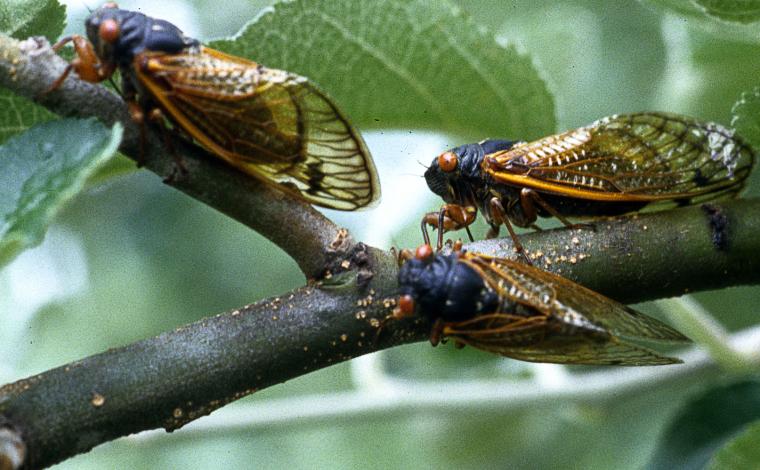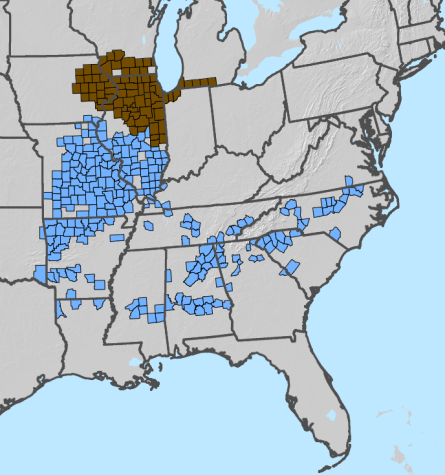
KANSAS CITY, Mo. – Billions of cicadas will buzz this spring as two broods emerge at the same time. These broods last emerged together in 1803 and won’t appear together again for 221 years.
That means that your grandchildren’s great-great-great grandchildren likely will be the next group to experience the dual emergence of these cicada broods that appear in 13- and 17-year life cycles, says University of Missouri Extension specialist Tamra Reall.
“It will be crazy,” she says, and she can’t wait. Reall is a horticulturist in the Kansas City area and an entomologist known as “Dr. Bug.”
Periodical cicadas have the longest known life cycle of any insect. Broods are groups of cicadas that share the same emergence years. Broods receive a number listed as a Roman numeral. Brood XIII only emerges every 17 years while Brood XIX emerges every 13 years.
The last time these two particular broods emerged together was when Thomas Jefferson was president, decades before Missouri statehood. The next event will be in the year 2245.
Periodical cicadas belong to the genus Magicicada. “No surprise that it’s called the ‘Magicicada,’ because it’s magical,” says Reall.
Emergence will occur in 18 Midwestern states. For the most part, most Missourians will only experience Brood XIX, the Great Southern Brood, which last appeared in Missouri in 2011. Expect them to emerge in late April to early May, says Reall.

Those in northeastern Missouri near the Illinois border might see – and hear – both broods.
Cicada nymphs stay in the soil for 13 or 17 years, depending on their brood. They emerge when the soil warms to 64 degrees and dig their way out of the ground. They subscribe to the “safety in numbers” approach and emerge all at once. They climb trees, fence posts or anything vertical before shedding their hard skins. Then they head to treetops to mate, lay their eggs and die within four to six weeks.
Expect to see cicadas after a spring rain, and expect to see a lot of them – as many as 1.5 million per acre, says Reall. This creates a feeding frenzy for predators and litter so heavy that the sidewalks and highways may need shoveling.
Brood XIX, a 13-year brood, has four species. Other states that will see Brood XIX include Alabama, Arkansas, Georgia, Indiana, Kentucky, Louisiana, Maryland, Mississippi, North Carolina, Oklahoma, South Carolina, Tennessee and Virginia. These will emerge late April through the second week of May.
Brood XIII, the Northern Illinois Brood, is a 17-year cicada with three species. It will appear in Iowa, Illinois, Indiana, Wisconsin and possibly Michigan in 2024. Some stragglers may make their way into southern Illinois and the St. Louis area. Expect emergence mid-May through June.
The loud sound you hear is from male cicadas as they send out their mating call, which can be as loud as a lawnmower and is unique to its species, Reall says. The synchronized male singing can be louder than a jet engine.
With five eyes each, they truly are on the lookout for a mate. They have only four to six weeks from the time they emerge from the soil to ensure the next generation of offspring. Once they mate, the males soon die.
After the female lays her eggs in the tree’s branches, her work is done as well, and she also dies. Her nymphs fall to the ground, burrow into the soil and begin the process all over again.
Cicadas are drawn to the vibrating sounds of power tools and lawn mowers.
Cicadas, while loud and messy, are harmless to humans and their pets, says Reall. They don’t sting or bite. She warns against using pesticides that will harm birds and beneficial insects such as butterflies, bees and moths. If there is concern about new trees or bushes, protect them with a loose cover of cheesecloth.